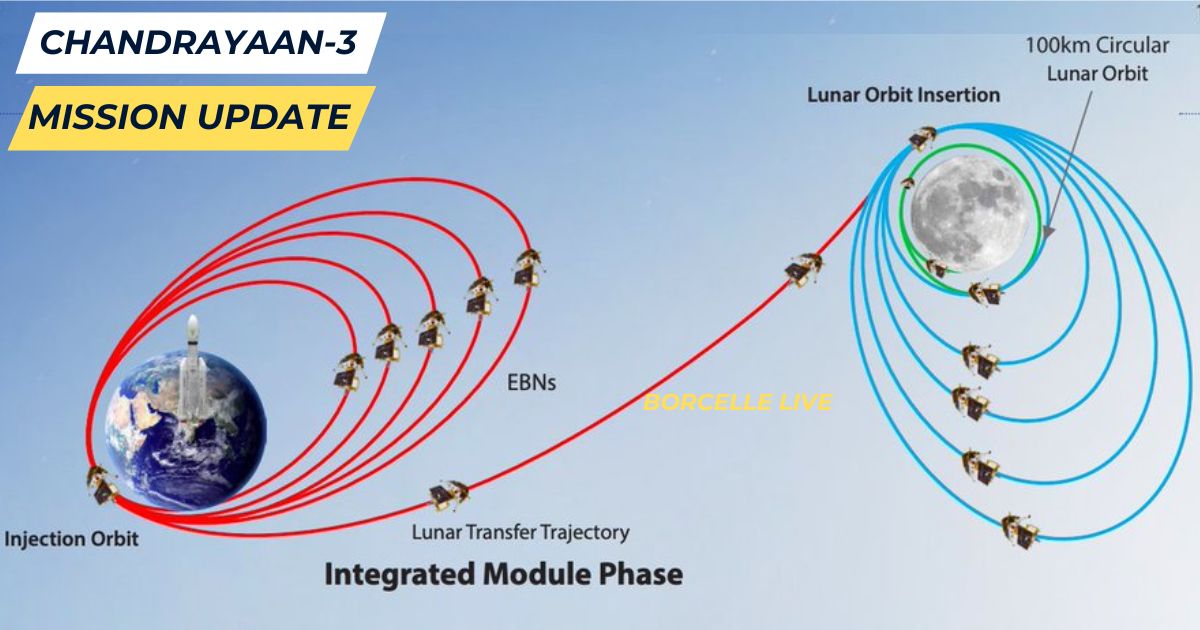In an exciting development for India’s space exploration program, the Chandrayaan-3 mission has achieved a significant milestone. The spacecraft’s health is reported to be normal, indicating that it is operating as expected.
This encouraging news comes as the Indian Space Research Organisation (ISRO) successfully performed the first orbit-raising maneuver, known as Earthbound firing-1, at the ISRO Telemetry, Tracking and Command Network (ISTRAC) in Bengaluru.
Following the successful maneuver, the Chandrayaan-3 spacecraft transitioned to a new orbit, measuring 41762 km x 173 km. This change in orbit brings the mission one step closer to its ultimate destination: the Moon.
The Chandrayaan-3 mission is the third installment in India’s ambitious lunar exploration program. Its predecessor, Chandrayaan-2, made history in September 2019 by attempting to land a rover on the lunar surface. Although the mission encountered an unexpected anomaly during the landing phase, it still provided valuable insights and data on the Moon’s composition and surface.
Building upon the knowledge gained from Chandrayaan-2, Chandrayaan-3 aims to complete the unfinished task of landing a rover on the Moon. The mission carries the hopes and aspirations of the Indian scientific community and the nation as a whole.
As we celebrate this milestone, it is important to reflect on the rich history of space exploration that has led us to this point. Space agencies from around the world have contributed to the advancement of human knowledge and our understanding of the cosmos. Here is a brief overview of some prominent space agencies and their founding years:
- NASA (1958): The National Aeronautics and Space Administration, established by the United States, has been at the forefront of space exploration for over six decades, pioneering numerous missions and technological advancements.
- CNES (1961): The Centre National d’Études Spatiales, founded in France, has been a driving force in Europe’s space endeavors, collaborating with various international partners.
- SUPARCO (1961): The Space and Upper Atmosphere Research Commission, established in Pakistan, has been actively involved in space research and satellite development.
- ISRO (1969): The Indian Space Research Organisation, India’s national space agency, has made significant contributions to space science, satellite technology, and lunar exploration.
- DLR (1969): The German Aerospace Center, based in Germany, conducts research and development in various aerospace fields, contributing to European space missions.
- ESA (1975): The European Space Agency, an intergovernmental organization with 22 member states, has been at the forefront of space research, exploration, and satellite deployment.
- ISA (1983): The Israeli Space Agency has made remarkable strides in space research and satellite technology, enabling Israel’s presence in the global space community.
- Roscosmos (1992): The Russian Space Agency, successor to the Soviet space program, has been instrumental in human spaceflight, lunar missions, and the exploration of other celestial bodies.
- CNSA (1993): The China National Space Administration has rapidly emerged as a major space power, with notable achievements such as lunar exploration and crewed space missions.
- AEB (1994): The Brazilian Space Agency has been involved in various space projects, including satellite launches and space research.
- ASI (1998): The Italian Space Agency plays a significant role in space exploration, satellite development, and international collaborations.
- Blue Origin (2000): Founded by Jeff Bezos, Blue Origin aims to make space more accessible through the development of reusable rockets and spacecraft.
- SpaceX (2002): Elon Musk’s SpaceX has revolutionized the space industry with its innovative approach to rocket technology, including the development of reusable boosters.
- JAXA (2003): The Japan Aerospace Exploration Agency leads Japan’s space exploration efforts, encompassing satellite deployment, lunar missions, and international collaborations.
- ISA (2004): The Iranian Space Agency conducts space research, satellite launches, and contributes to the development of Iran’s space program.
- UKSA (2010): The United Kingdom Space Agency coordinates the country’s space activities, supporting satellite launches, space research, and commercial partnerships.
- NADA (2013): The National Aerospace Development Administration of North Korea is involved in the country’s space program, including satellite launches.
- UAESA (2014): The United Arab Emirates Space Agency oversees the country’s space initiatives, including satellite launches and the ambitious Emirates Mars Mission.
- Australian Space Agency (2018): Australia’s national space agency facilitates the growth of the country’s space industry, fostering innovation and international collaboration.
- Turkish Space Agency (2018): The Turkish Space Agency aims to develop Turkey’s space capabilities, including satellite development and space research.
- EUSPA (2021): The European Union Agency for the Space Programme is responsible for the coordination and implementation of the European Union’s space activities.
With each space agency contributing its unique expertise and resources, humanity continues to push the boundaries of exploration and expand our understanding of the universe. The Chandrayaan-3 mission is a testament to India’s commitment to scientific progress and its determination to leave a lasting impact on lunar exploration.
As the Chandrayaan-3 mission progresses, we eagerly anticipate further updates and milestones that will bring us closer to India’s goal of landing a rover on the Moon’s surface. The successful completion of the first orbit-raising maneuver is a promising sign that the mission is on track, and we look forward to witnessing the next stages of this remarkable journey.


